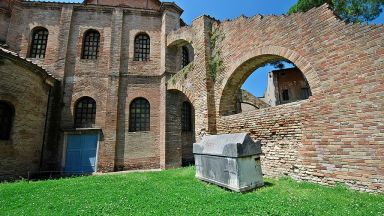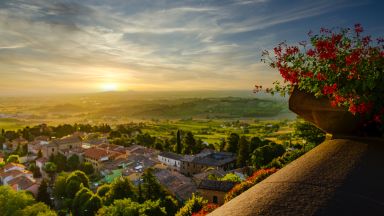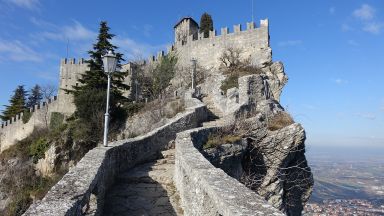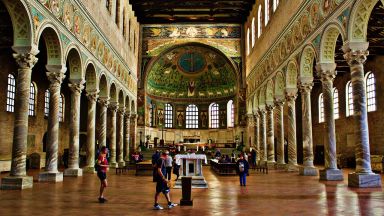Basilica of San Vitale
Basilica in Ravenna

The Basilica of San Vitale, a UNESCO World Heritage monument since 1996, is a must-visit if you wish to experience the true essence of mosaic art in Ravenna. This basilica ranks among the most important early Christian art monuments in Italy and globally. Situated in the heart of Ravenna, it’s conveniently located near several captivating historic sites, including the Mausoleum of Galla Placidia, the Domus of the Stone Carpets, the National Museum, and more.
The basilica was commissioned during the Gothic kingdom, under the rule of Bishop Ecclesius (525-526 AD). It was made possible by a substantial donation of 26,000 gold coins from the banker Giuliano Argentario, and it was completed just two decades later during the reign of Justinian. In 547 AD, Archbishop Maximian consecrated the basilica to St. Vitale, a Christian martyr from the early centuries.
The basilica’s location holds historical significance, as legend has it that it was built upon the site where a 5th-century sacellum with the remains of Saint Vitale was discovered. Regardless of legend, it was strategically placed just outside the city walls of the Roman era, surrounded by elegant domus (residential buildings). Additionally, it stood in proximity to other prestigious sites such as the Basilica of Santa Croce and the Mausoleum of Galla Placidia.
The basilica’s architectural design departs from the conventional basilica plan. It consists of two brick-built prismatic blocks, one higher and one lower, both with octagonal plans. Surrounding the tambour of the central dome is a two-story ambulatory (corridor) with a women’s gallery (matroneo). Facing east, the polygonal apse is flanked by two rectangular sacristies, while on the opposite side, the entrance portico (narthex), uniquely set askew from the apse, has two exedras leading to the two towers and the upper sectors.
Upon entering the basilica, one is immediately captivated by the breath-taking mosaic decorations in the apse, the expansive open spaces, and the imposing central vault adorned with 18th-century frescoes. It is a space so vast that one’s gaze struggles to take it all in. The interplay of light seeping through the windows creates captivating and evocative effects against the backdrop of the mosaic decorations and marble surfaces.
The interior, rich in precious marbles, boasts an exceptional example of mural mosaic art that stretches vertically. It imparts an imperial aura and symbolizes the political and religious power of the era. While the mosaic figures in the presbytery, depicting episodes from the Old and New Testaments, appear three-dimensional and worldly, those in the apse, featuring Emperors Theodoric and Justinian and Archbishop Maximian, stand hieratically against a golden, nearly abstract background, emphasizing the sense of the transcendent, metaphysical power of the Church and Justinian’s dogmatic and political influence.
Furthermore, don’t overlook the circular marble labyrinth near the presbytery, just in front of the altar. This labyrinth symbolizes rebirth, and navigating its intricate paths represents a spiritual journey.
The Basilica of San Vitale appears in our Complete Guide to Visiting Ravenna!
This website uses affiliate links which may earn a commission at no additional cost to you!
Visiting Basilica of San Vitale
Every day: 9 am – 7 pm
€ 10.50
Nearby Attractions
- National Museum of Ravenna (0.0) km
Historic Building and Museum in Ravenna - Mausoleum of Galla Placidia (0.1) km
mausoleum in Ravenna - Domus dei Tappeti di Pietra (House of the Stone Carpets) (0.2) km
Historic Site and Museum in Ravenna - Piazza del Popolo, Ravenna (0.4) km
Square in Ravenna - Arian Baptistery (Battistero degli Ariani) (0.5) km
Baptistery in Ravenna - Battistero Neoniano (o degli Ortodossi) (0.6) km
Baptistery in Ravenna - Museo Dante, Ravenna (0.6) km
Historic Building and Museum in Ravenna - Archbishop's Museum, Ravenna (0.6) km
Museum in Ravenna - Dante Alighieri’s Tomb (0.6) km
Tomb in Ravenna - Archbishop's Chapel of St. Andrew (0.6) km
Church in Ravenna


